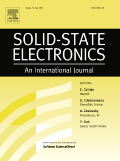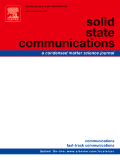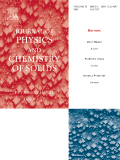
SOLID-STATE ELECTRONICS
Scope & Guideline
Bridging Theory and Application in Electronics
Introduction
Aims and Scopes
- Solid-State Device Physics and Engineering:
Research on the underlying physics of solid-state devices, including transistors, diodes, and memristors, with a focus on improving their performance and reliability. - Materials Science for Electronics:
Studies involving the synthesis, characterization, and application of novel materials such as semiconductors, dielectrics, and conductors in electronic devices. - Modeling and Simulation Techniques:
Development and application of computational models and simulation tools to predict device behavior and optimize design parameters. - Emerging Technologies and Applications:
Exploration of new technologies such as quantum computing, neuromorphic computing, and energy-efficient devices, focusing on their potential impact and applications. - Reliability and Degradation Studies:
Investigation into the reliability issues and degradation mechanisms of solid-state devices under various operational conditions, aiming to enhance longevity and performance.
Trending and Emerging
- 2D Materials and Devices:
Research on 2D materials like graphene and transition metal dichalcogenides is trending, driven by their unique electronic properties and potential applications in next-generation electronics. - Quantum Computing and Qubit Technologies:
There is a significant increase in studies related to quantum computing, specifically focusing on qubit design and quantum dot systems, indicating a growing interest in harnessing quantum mechanics for computational advancements. - Neuromorphic Computing and Artificial Intelligence:
Research on devices mimicking neural functions, such as memristors and synaptic transistors, is on the rise, reflecting the increasing integration of AI into electronic systems. - Energy-Efficient and Green Electronics:
Emerging themes include the development of low-power devices and materials aimed at enhancing energy efficiency, aligning with global sustainability goals. - Advanced Characterization Techniques:
There is a trend towards utilizing advanced characterization methods, such as machine learning and AI-driven analysis, to better understand device performance and material properties.
Declining or Waning
- Conventional Silicon Technologies:
Research specifically focused on traditional silicon-based devices has seen a reduction, as the field increasingly shifts towards novel materials and architectures that offer improved performance. - Basic Fabrication Techniques:
Studies centered on conventional fabrication processes are less frequent, as innovations in nanofabrication and advanced techniques become more prevalent. - Low-Temperature Electronics:
Research on low-temperature applications has decreased, possibly due to the growing interest in room-temperature applications and devices that operate efficiently at ambient conditions. - Analog Device Applications:
There is a waning interest in purely analog devices as the focus shifts to digital and mixed-signal applications, driven by the rise of integrated systems and digital technologies.
Similar Journals

Journal of Electronics & Information Technology
Illuminating Pathways in Electronics and Information TechnologyJournal of Electronics & Information Technology, published by the prestigious Chinese Academy of Sciences, Institute of Electronics, stands as a vital resource in the field of Electrical and Electronic Engineering. With an ISSN of 1009-5896, this journal has been dedicated to the dissemination of advanced research and innovative applications since its inception in 2001. It holds a competitive position within its category, ranked Q3 in the 2023 Scopus database, reflecting its contribution to the scientific community. The journal addresses a wide array of topics related to electronics and information technology, making it indispensable for researchers, professionals, and students aiming to stay at the forefront of technological advancements. Although it operates under a traditional model of access, its cumulative output remains pivotal for knowledge sharing and innovation in the rapidly evolving landscape of electronic engineering. With its commitment to excellence, the Journal of Electronics & Information Technology aims to foster a thriving academic environment and promote impactful research within the discipline.

SOLID STATE COMMUNICATIONS
Advancing Knowledge in Chemistry and PhysicsSOLID STATE COMMUNICATIONS is a prestigious journal published by Pergamon-Elsevier Science Ltd, dedicated to disseminating cutting-edge research in the fields of Chemistry, Condensed Matter Physics, and Materials Chemistry. With an ISSN of 0038-1098 and an E-ISSN of 1879-2766, the journal has established itself as a vital resource for researchers and professionals seeking to explore the fundamental properties and innovative applications of solid-state materials. As of 2023, it boasts a commendable standing, ranking in the Q2 quartile across its various categories, reflecting its impactful contributions to the scientific community. The journal is indexed in Scopus, further validating its relevance and quality, with notable ranks close to the median percentile in key areas. While SOLID STATE COMMUNICATIONS does not currently offer Open Access options, it remains a highly regarded source for rigorous scientific inquiry and open discussions, with a publication history dating back to 1963 and continuing to 2024. The journal serves as an essential platform for disseminating groundbreaking findings and fostering collaboration within the vibrant fields of solid state science.

INFORMACIJE MIDEM-JOURNAL OF MICROELECTRONICS ELECTRONIC COMPONENTS AND MATERIALS
Exploring the Future of Microelectronics and Materials ScienceINFORMACIJE MIDEM - JOURNAL OF MICROELECTRONICS ELECTRONIC COMPONENTS AND MATERIALS is a prominent open-access journal published by SOC MICROELECTRONICS, ELECTRON COMPONENTS MATERIALS-MIDEM in Slovenia, dedicated to advancing knowledge in the fields of microelectronics, electronic components, and materials. Since its inception in 1988, the journal has provided a platform for groundbreaking research and innovations, ensuring that all published work is freely accessible to a global audience. With an impressive history of publication from 1996 to 2024, INFORMACIJE MIDEM is indexed in Scopus, holding respectable ranks in categories such as Electrical and Electronic Engineering (Rank #525/797, Percentile 34th) and Electronic, Optical, and Magnetic Materials (Rank #204/284, Percentile 28th). While currently classified in the Q4 quartile for the year 2023, the journal serves as an essential resource for researchers, professionals, and students seeking the latest developments in microelectronics and related fields, fostering a collaborative academic environment and contributing to the advancement of technology and materials science.

Photonics, an esteemed journal published by MDPI, is a leading platform for researchers in the fields of atomic and molecular physics, optics, and instrumentation. Since its inception in 2014, the journal has fostered open access to cutting-edge research, facilitating knowledge dissemination in these dynamic disciplines. With its Q2 ranking in the 2023 Scopus metrics for various categories, including radiology, nuclear medicine, and imaging, Photonics represents a crucial academic resource for professionals and students seeking to advance their understanding and expertise. Located in Basel, Switzerland, the journal plays a pivotal role in bridging theoretical and practical approaches to photonic technologies. Researchers are encouraged to contribute their findings, thereby enriching the journal’s impact and relevance in the global scientific community through collaboration and innovation.

JOURNAL OF PHYSICS AND CHEMISTRY OF SOLIDS
Illuminating the Science of SolidsJOURNAL OF PHYSICS AND CHEMISTRY OF SOLIDS, published by Pergamon-Elsevier Science Ltd, is a distinguished international journal that has been at the forefront of disseminating cutting-edge research in the fields of physics, chemistry, and materials science since its inception in 1956. This journal, which is recognized for its high impact in the Q2 category across multiple subjects—including Chemistry (miscellaneous), Condensed Matter Physics, and Materials Science—serves as a vital platform for researchers, professionals, and students to engage with significant advances in solid-state physics and chemistry. With Scopus rankings placing it in the top 15% of its field across various domains, the journal plays a crucial role in shaping the scientific dialogue surrounding materials properties, synthesis, and applications. Although it does not currently offer open access options, the presented research is widely recognized for its quality and relevance, ensuring that published works contribute meaningfully to ongoing scholarly discussions.

ACS Applied Electronic Materials
Pioneering Insights in Optical and Magnetic MaterialsACS Applied Electronic Materials, published by the American Chemical Society, is a prominent journal in the field of applied materials science, with a particular focus on electronic, optical, and magnetic materials. Established in 2019, this journal has quickly risen to prominence, achieving a 2023 ranking of Q1 in both Electronic, Optical and Magnetic Materials and Materials Chemistry, as well as Q2 in Electrochemistry, reflective of its high-quality contributions and significant impact within the scholarly community. With an impressive Scopus rank of #22 in Electrochemistry, #59 in Electronic, Optical and Magnetic Materials, and #75 in Materials Chemistry, ACS Applied Electronic Materials serves as an essential resource for researchers, professionals, and students seeking to explore innovative advancements in the field. While the journal is not open access, it offers robust subscription options and aims to foster the dissemination of cutting-edge research articles, reviews, and technical notes that contribute to the understanding and application of electronic materials in various technological contexts. As a platform for pioneering research and cross-disciplinary dialogue, this journal is indispensable for anyone invested in the future of materials science.

JOURNAL OF PHYSICS-CONDENSED MATTER
Pioneering Discoveries in Condensed Matter and Materials Science.JOURNAL OF PHYSICS-CONDENSED MATTER, published by IOP Publishing Ltd, stands as a premier platform for the dissemination of impactful research in the fields of condensed matter physics and materials science. Since its inception in 1989, this journal has successfully bridged the gap between fundamental and applied research, delivering cutting-edge findings pertinent to both the academic community and industry professionals. Ranking in the Q2 category for both Condensed Matter Physics and Materials Science, it holds a respectable position within the scientific community, as evidenced by its Scopus rankings. With a commitment to fostering innovative research and promoting open dialogue, the journal offers a substantial collection of articles that contribute to the evolving landscape of materials science and physics. Researchers and students are encouraged to engage with the journal’s rich content, which not only enhances their academic pursuits but also plays a crucial role in advancing technologies based on solid-state materials.

Advanced Electronic Materials
Unlocking Potential in Electronic and Optical TechnologiesAdvanced Electronic Materials is an esteemed journal published by Wiley, dedicated to the forefront of materials science, particularly in the areas of electronic, optical, and magnetic materials. With a commendable impact factor that places it in the Q1 quartile of its category and a Scopus rank of 36 out of 284, the journal is a vital resource for researchers, professionals, and students aiming to contribute to this rapidly evolving field. Launched in 2015 and fully transitioned to Open Access in 2023, the journal promotes widespread dissemination of knowledge, ensuring accessibility to groundbreaking research findings. With its address located in Germany at 111 River St, Hoboken 07030-5774, NJ, it serves a global academic community eager to explore innovative materials technologies that influence diverse applications ranging from consumer electronics to advanced manufacturing. As researchers seek to push the boundaries of what is possible with materials, Advanced Electronic Materials stands as a premier platform for sharing, discovering, and advancing knowledge in this essential domain.

LASER PHYSICS LETTERS
Elevating the Standards of Laser ResearchLASER PHYSICS LETTERS is a prestigious peer-reviewed journal published by IOP Publishing Ltd in the United Kingdom, focusing on the burgeoning field of laser physics and its applications. With an ISSN of 1612-2011 and an E-ISSN of 1612-202X, this journal stands at the intersection of innovative research and practical applications, addressing diverse topics within the realms of Instrumentation and Physics and Astronomy. Recognized for its impactful contributions, it boasts a ranking within the Q3 quartile for both relevant categories as of 2023, reflecting its steady rise and commitment to advancing knowledge in the area. Researchers and practitioners are encouraged to explore its content and contribute to the ongoing discourse that shapes the future of laser technologies. While LASER PHYSICS LETTERS does not currently offer open access options, its rigorous selection criteria ensure that published work is of the highest quality, positioning it as a vital resource for anyone engaged in laser science and engineering.

ORGANIC ELECTRONICS
Leading the Charge in Interdisciplinary ResearchORGANIC ELECTRONICS, published by Elsevier, is a premier journal dedicated to the rapidly evolving field of organic electronics, encompassing a spectrum of interdisciplinary research from materials chemistry to electrical engineering. As a crucial resource for researchers, professionals, and students, the journal boasts significant impact, currently ranked in the Q2 category across multiple fields, including Condensed Matter Physics, Materials Chemistry, and Electrical and Electronic Engineering. With a commitment to advancing knowledge and innovation from its base in the Netherlands since its inception in 2000, ORGANIC ELECTRONICS not only provides critical insights into organic materials and their applications but also fosters collaboration among scientists through its comprehensive findings and high-quality articles. The journal does not currently offer open access but provides various access options for subscribers. With its HIndex signaling substantial academic output and engagement, ORGANIC ELECTRONICS remains an essential platform for groundbreaking research that is shaping the future of technology.